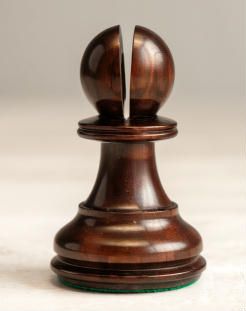The Piececlopedia: Berolina Pawn
Historic remarks

The Berolina Pawn has been introduced by E. Nebermann in 1926. The pawn is named after the city of Berlin. It is one of the most popular fairy chess pieces, because its movement rules are a logical twist of the rules for the pawn.
Movement rules
Berolina paws can only move forward. When a Berolina pawn makes a non-capturing move, it goes one square diagonally forwards. When a Berolina pawn is still on its original square on the second row, it can make a non-capturing move diagonally forwards of one or of two squares - if it moves two squares, the first square must be empty. A pawn captures one square vertically forwards.
When a Berolina pawn has moved two squares forwards, the opponent has the possibility to take it en passant: in the directly following turn a (Berolina) pawn of the opponent may take it also on the square that was passed by.
When a Berolina pawn reaches a promotion square, that is, a square on the last row of the board at the opponents side, it promotes. The owner of the Berolina pawn may decide to which piece the pawn promotes. In general, the choice is between queen, rook, knight, bishop, or any non-standard non-royal chess piece that is present in the array (but, of course, not a pawn or Berolina pawn.)
Movement diagram
The positions where the pawn can move to without taking are marked with a green circle; the positions where the pawn can move to with taking are marked with a red circle.

Written by Hans Bodlaender.
WWW page created: October 13, 1998.
